
Timpanogos Cave National Monument is a United States National Monument protecting the Timpanogos Cave Historic District and a cave system on Mount Timpanogos in American Fork Canyon in the Wasatch Range, near Highland, Utah, in the United States. The site is managed by the National Park Service. The 1.5-mile (2.4 km) trail to the cave is steep, gaining close to 1,000 feet (300 m), but paved and fairly wide, making the caves accessible to most. The three caves of the system, one of which is specifically called Timpanogos Cave, are only viewable on guided tours when the monument is open, usually from May through September depending on snow conditions and funding. There is the standard tour going through the cave system, and an Introduction to Caving tour which teaches Leave No Trace caving and goes further into Hansen Cave.

Camp Douglas was established in October 1862, during the American Civil War, as a small military garrison about three miles east of Salt Lake City, Utah, to protect the overland mail route and telegraph lines along the Central Overland Route. In 1878, the post was renamed Fort Douglas. It was officially closed in 1991 pursuant to BRAC action and most of the buildings were turned over to the University of Utah. A small section of the original fort is still used by the U.S. Army Reserve and includes the Fort Douglas Military Museum. The fort was designated a National Historic Landmark in 1975, for its role in the Civil War and in furthering the settlement of Utah.

This is a list of the National Register of Historic Places listings in Summit County, Utah.
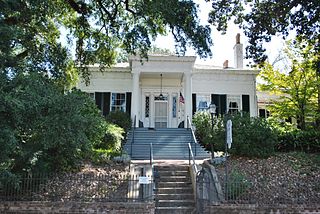
"Green Leaves", also known as the Koontz House or the Beltzhoover House, is a Greek Revival mansion in Natchez, Mississippi, completed in 1838 by Edward P. Fourniquet, a French lawyer who built other structures in the area. It was purchased by George Washington Koontz, a local banker in 1849 and has been owned by his descendants ever since. It was listed on the National Register of Historic Places (NRHP) in 1979.

The University of Utah Circle, also known as Presidents Circle, is located on the campus of the University of Utah in Salt Lake City, Utah, United States. It was listed on the National Register of Historic Places in 1978 as a historic district.

The Knight–Mangum House is a historic house located in Provo, Utah, United States. It is listed on the National Register of Historic Places. The mansion was built in the old English Tudor style, completed in 1908. It was built for Mr. W. Lester Mangum and his wife Jennie Knight Mangum. Mrs. Mangum was the daughter of the famous Utah mining man, Jesse Knight. The lot was purchased for $3,500 and the home was built at a cost of about $40,000. The Mangum family was able to afford the home due to the fact that they had sold their shares in Jesse Knight's mine located in Tintic, Utah, for eight dollars a share. They had purchased the shares for only twenty cents a share, so the excess allowed them enough funds to purchase the home. The contractors for the home were the Alexandis Brothers of Provo.
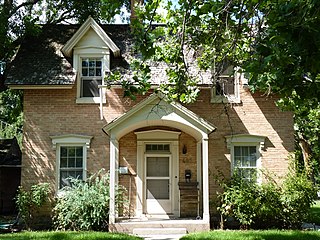
The Johnson–Hansen House is a historic house located in Provo, Utah, United States, that is listed on the National Register of Historic Places.
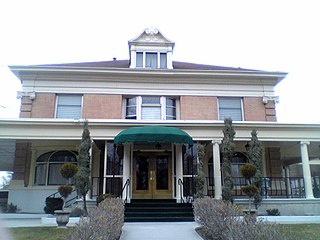
The Jesse Knight House, also known as the Knight Mansion, is a historic house in Provo, Utah, United States built for Jesse Knight. It was built in 1905, and added to the National Register of Historic Places in 1982. This home was designated to the Provo City Historic Landmarks Register on June 19, 1996.

The Hines Mansion is a historic house in Provo, Utah, United States. It is listed on the National Register of Historic Places. It was built in 1895 for R. Spencer Hines and his wife Kitty. At the time the mansion was built, it was recognized as one of the finest homes in Provo. The Hines Mansion was designated to the Provo City Historic Landmarks Registry on March 7, 1996.

The George Angus and Martha Ansil Beebe House is a historic house located in Provo, Utah, United States. It is listed on the National Register of Historic Places.

The Superintendent's Residence at the Utah State Hospital is a historic house located at the Utah State Hospital in east Provo, Utah, United States. It was listed on the National Register of Historic Places in 1986.
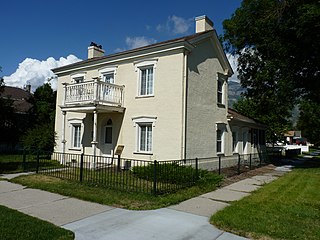
The Clark–Taylor House is a historic building located in Provo, Utah, United States. It is listed on the National Register of Historic Places. It has also been known as the T. N. Taylor Home. One of the oldest pioneer buildings in the state, the Clark–Taylor House was built around 1854. Thomas N. Taylor, a Provo Mayor, LDS bishop, and stake president, along with being a chairman of the board of trustees of BYU, lived in this home. The Clark–Taylor House was designated to the Provo City Historic Landmarks Registry on March 7, 1996.

The Cordner–Calder House at 305 S. 900 E. in Orem, Utah is a Victorian-style house which was built in 1894 by William Cordner and was expanded around 1910. The home is associated with two families, the Corders and the Calders, both of which were "prominent fruit growers on the Provo Bench" whose "participation and influence in the growth of Orem is reflected in this house".
Frederick Albert Hale was an American architect who practiced in states including Colorado, Utah, and Wyoming. According to a 1977 NRHP nomination for the Keith-O'Brien Building in Salt Lake City, "Hale worked mostly in the classical styles and seemed equally adept at Beaux-Arts Classicism, Neo-Classical Revival or Georgian Revival." He also employed Shingle and Queen Anne styles for several residential structures. A number of his works are listed on the U.S. National Register of Historic Places.

The Perry and Agnes Wadsworth Fitzgerald House, at 1160 East Pioneer Road in Draper, Utah, United States, was built in 1870 as the home for Perry Fitzgerald's third polygamous wife Agnes, who had 13 children. It was listed on the National Register of Historic Places in 2004.

The Peter Hansen House, located at 247 S. 200 East in Manti, Utah, was built in 1875. It is historically significant as a Scandinavian-American folk architecture example. It was built by Danish-born brickmason Peter Hansen who immigrated in the 1860s. As brick was rare in Manti before the 1880s, it is believed that Hansen fired bricks for this house in a kiln on the property. The house was sold for $500 in 1882.

The Absalom Thompson House is a historic house located two miles south of Spring Hill, Tennessee.

The William Thompson Jr. House, at 10 W. 400 North in Beaver, Utah, was built around 1880 by Scottish-born local stonemason Thomas Frazer. It was listed on the National Register of Historic Places in 1982.

The Peterson–Burr House is a historic two-story house in Salina, Utah. It was built in 1900 by P. J. Peterson, an immigrant from Denmark who became a furniture and hardware store owner in Salina, and served as the mayor and as a member of the Utah State Legislature. The house was designed in the Queen Anne architectural style. It belonged to Gilbert M. Burr, a car dealer and Mormon bishop, from 1919 to 1982, and it was remodelled as a bed and breakfast in 1983. It has been listed on the National Register of Historic Places since February 18, 1994.
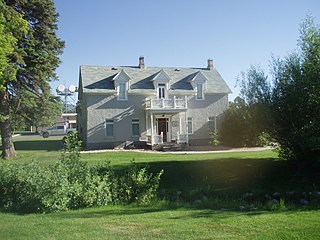
The Hans A. Hansen House is a historic house in Ephraim, Utah. It was built in 1862 by Hans A. Hansen, an immigrant from Denmark who converted to The Church of Jesus Christ of Latter-day Saints and arrived in Utah in 1853. Hansen had two wives: Annie, who had emigrated to the United States with him, and Mary Christiansen. He built a second house in the Scandinavian style, but this house was designed in a Vernacular English, or "traditionally American", style, which is interpreted by Tom Carter of the Utah State Historical Society as Hansen's willingness to integrate in American society. The house has been listed on the National Register of Historic Places since October 22, 1980.























